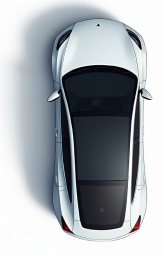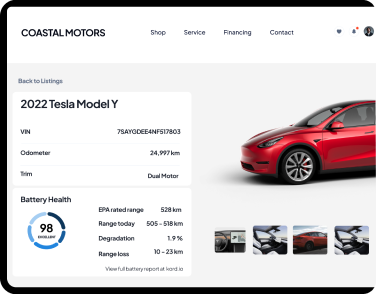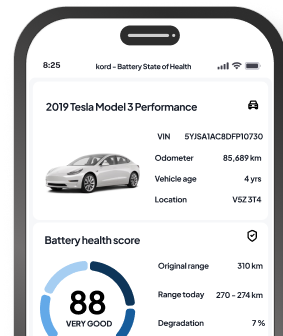Kord EV Report

2022 Tesla Model Y
Long Range AWD
VIN
7SAYGDEE4NF517803
Odometer
30,400 km
Vehicle age
3 yrs
Predicted range
505
km
Battery warranty
60
months
or 163K km remaining
Fuel savings
$2,103
annual vs. similar gas vehicle
Charging: 20-80%
14
min
DC fast charger, 150 kW+
Insights
Range
Predictive range
505
km
Original range
531 km
Predictive battery health
95%
Degradation
5%
Range loss
26 km
Learn more
Our range and battery health data is generated using advanced predictive modeling techniques. For the most accurate assessment of vehicle battery range and health, users should refer to official vehicle systems. A precise evaluation requires specialized testing by certified technicians.
Go back
Battery info
Capacity
82 kw | Lithium-ion
Build year
2022
OEM battery warranty
193,000 km | 8 years
Warranty remaining
162,600 km | 5 years
Predicted range in weather - V5Y 1V4
Warm13-18°C
505 km
Mild9-13°C
465 km
Cold4-9°C
354 km
Charging
Range per 10 minute charge
201
km
DC fast charger (150+ kW)
8
km
level 2 charger (10+ kW)
Learn more
Charging your electric vehicle (EV) can take different amounts of time depending on two main things:
1. Your car's ability to accept power
2. The charger's power output
Public fast chargers are much more powerful than home chargers:
• Public DC fast chargers: 50 kW to 350 kW
• Home Level 2 chargers: 3.3 kW to 19.2 kW
Your EV charges fastest when the battery is between 20% and 80% full. After that, it slows down to protect the battery. So, even with a fast charger, that last 20% takes longer. Actual charging times may vary based on these factors and your specific car model.
Go back
Charging: 20-80%
14
mins
DC fast charger (150+ kW)
6.4
hrs
level 2 charger (10+ kW)
Learn more
Charging your electric vehicle (EV) can take different amounts of time depending on two main things:
1. Your car's ability to accept power
2. The charger's power output
Public fast chargers are much more powerful than home chargers:
• Public DC fast chargers: 50 kW to 350 kW
• Home Level 2 chargers: 3.3 kW to 19.2 kW
Your EV charges fastest when the battery is between 20% and 80% full. After that, it slows down to protect the battery. So, even with a fast charger, that last 20% takes longer. Actual charging times may vary based on these factors and your specific car model.
Go back
Fuel efficiency & Carbon
Fuel savings
$2,103
EV savings / yr.
Based on 20,000 km driven annually
Savings compared to a gas Crossover
EV cost / mo.
$48.72
Gas cost / mo.
$223.99
EV savings / mo.
$175.27
Savings vs gas
78%
Learn more
Fuel savings comparison based on:
- Current day gas price of $1.485/L in BC
- Current day national average electricity cost is $0.168 per kw
- Energy consumed is 17 kWh/100km driven based on EPA estimates
Go back
Carbon footprint
86%
Reduction vs a gas Crossover
EV CO2 / year
0.59 metric tons
Gas CO2 / year
4.16 metric tons
CO2 reduction / year
3.57 metric tons
Learn more
Based on U.S EPA estimations;
For gas vehicles:
- Tailpipe-CO2 Emissions from a gallon of gasoline = 8,887 grams CO2/ gallon
- Upstream-Tailpipe CO2 emissions are multiplied by a national average factor of 1.25 to account for emissions associated with gasoline production, e.g. drilling, refining, and transportation, etc
Go back
Kord provides estimated or predicted values for vehicle information.
Our product integrates data from diverse sources, including vehicle testing and advanced data modeling.
These are not actual results and should not be relied upon as definitive or guaranteed outcomes.
Report date: 07/17/2024
Our product integrates data from diverse sources, including vehicle testing and advanced data modeling.
These are not actual results and should not be relied upon as definitive or guaranteed outcomes.
Report date: 07/17/2024

